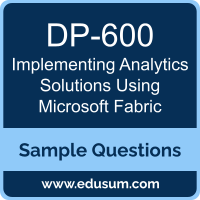01. You are developing a complex semantic model that contains more than 20 date columns. You need to conform the date format for all the columns as quickly as possible. What should you use?
a) ALM Toolkit
b) DAX Studio
c) Tabular Editor
d) VertiPaq Analyzer
02. You have a Fabric workspace that contains a complex semantic model for a Microsoft Power BI report. You need to optimize the semantic model for analytical queries and use denormalization to reduce the model complexity and the number of joins between tables.
Which tables should you denormalize?
a) dimension tables on the same level of granularity
b) fact tables on the same level of granularity
c) role-playing dimension tables
d) Snowflaked dimension tables
03. You have a Fabric workspace that contains a Microsoft Power BI report named Report1. Your organization does not currently have an enterprise data warehouse. You need to leverage dataflows to bring data into a Power BI semantic model. You notice that access to one of the data sources is restricted to narrow time windows.
What should you do?
a) Create a linked table that will reference the data from another dataflow.
b) Create a shared dataset that can be reused by multiple Power BI reports.
c) Create a staging dataflow that will only copy the data from the source as-is.
d) Create a transformation dataflow that will apply all the necessary data transformations.
04. You are developing a Microsoft Power BI semantic model. Two tables in the data model are not connected in a physical relationship. You need to establish a virtual relationship between the tables. Which DAX function should you use?
a) USERELATIONSHIP()
b) TREATAS()
c) PATH()
d) CROSSFILTER()
05. You have a Fabric tenant that contains a lakehouse named Lakehouse1. You have forecast data stored in Azure Data Lake Storage Gen2. You plan to ingest the forecast data into Lakehouse1. The data is already formatted, and you do NOT need to apply any further data transformations. The solution must minimize development effort and costs.
Which method should you recommend to efficiently ingest the data?
a) First, download the data to your computer, and then use Lakehouse explorer to upload it to Lakehouse1.
b) Use a Spark notebook.
c) Use Dataflow Gen2.
d) Use the Copy activity in a pipeline.
06. You have a Fabric tenant that contains a lakehouse named Lakehouse1. You plan to use Dataflow Gen2 to ingest and transform data from an Azure SQL Database into Lakehouse1. Which language should you use to transform the data in the dataflow?
a) DAX
b) M
c) SQL
d) XML
07. You are managing a set of Dataflow Gen2 queries that are currently ingesting tables into a Fabric lakehouse. You need to ensure that the tables are optimized for Direct Lake connections that will be used by connected semantic models. What should you do?
a) Apply an incremental refresh policy to the semantic model refreshes.
b) Run the VACUUM command.
c) Use OPTIMIZE to apply V-Order.
d) Use shortcuts to the lakehouse tables from the semantic models.
08. You have a Fabric tenant that contains a warehouse named Warehouse1. You have a large 1 TB dataset in an external data source. You need to recommend a method to ingest the dataset into Warehouse1. The solution must provide the highest throughput and support a low-code/no-code development model.
What should you recommend?
a) Copy data activity
b) Dataflow Gen2
c) Spark notebook
d) Shortcut
09. You have a Fabric workspace that contains a lakehouse named Lakehouse1. Lakehouse1 contains a Delta Parquet table named FactSales. You use a Describe command to review the history of FactSales and notice that you have over 1000 versions of the table, and the retention policy is six months.
You need to reduce the size of the FactSales table and the number of files in the table. What should you configure on the table?
a) Apply V-Order under Maintenance.
b) Delete the FactSales table from Lakehouse1.
c) Run the OPTIMIZE command under Maintenance.
d) Run the VACUUM command under Maintenance.
10. You have a Fabric tenant that contains a lakehouse named Lakehouse1. You have an external Snowflake database that contains a table with 200 million rows. You need to use a data pipeline to migrate the database to Lakehouse1.
What is the most performant (fastest) method for ingesting data this large (200 million rows) by using a data pipeline?
a) Data Pipeline (Copy data)
b) Data Pipeline (Dataflow Gen2)
c) Data Pipeline (Lookup)
d) Data Pipeline Spark (Notebook)
 The purpose of this Sample Question Set is to provide you with information about the Implementing Analytics Solutions Using Microsoft Fabric exam. These sample questions will make you very familiar with both the type and the difficulty level of the questions on the DP-600 certification test. To get familiar with real exam environment, we suggest you try our Sample Implementing Analytics Solutions Using Microsoft Fabric Certification Practice Exam. This sample practice exam gives you the feeling of reality and is a clue to the questions asked in the actual Microsoft Certified - Fabric Analytics Engineer Associate certification exam.
The purpose of this Sample Question Set is to provide you with information about the Implementing Analytics Solutions Using Microsoft Fabric exam. These sample questions will make you very familiar with both the type and the difficulty level of the questions on the DP-600 certification test. To get familiar with real exam environment, we suggest you try our Sample Implementing Analytics Solutions Using Microsoft Fabric Certification Practice Exam. This sample practice exam gives you the feeling of reality and is a clue to the questions asked in the actual Microsoft Certified - Fabric Analytics Engineer Associate certification exam.